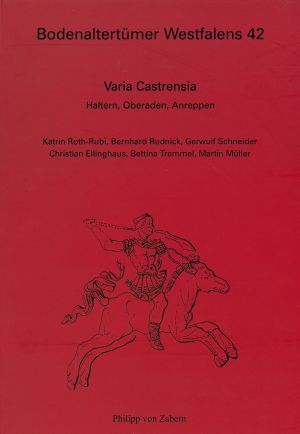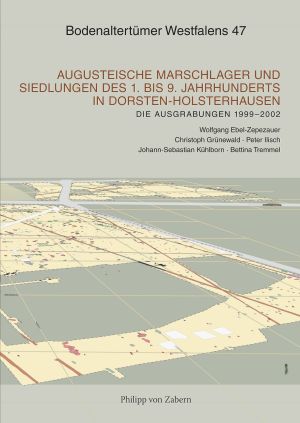Tremmel, Bettina
Varia Castrensia: Haltern, Oberaden, Anreppen
In the present volume, several authors present new finds from the Roman encampments of Haltern, Oberaden and Anreppen on the right bank of the Rhine in seven contributions. The first three contributions by K. Roth-Rubi, B. Rudnick and G. Schneider deal with the stamped Terra Sigillata found in Haltern and Oberaden over the past few decades and clearly document the places of origin of the ceramic with detailed diagrams and tables. C. Ellinghaus deals with the imagery of Roman legionaries and use the finds to shed light on the social history of Roman soldiers. With the glass vessels and glass beads from the three Lippe encampments, B. Tremmel presents one of the most important glass complexes of the early roman imperial period. M. Müller concludes with a helmet find and gives in a further contribution an overview of the range of forms of Roman bronze vessels from Oberaden based on two new finds.
Augusteische Marschlager und Siedlungen des 1. bis 9. Jahrhunderts in Dorsten-Holsterhausen: Die Ausgrabungen 1999 bis 2002
The LWL-Archaeology for Westphalia carried out its largest excavation to date from 1999 to 2002 at the Kreskenhof in Dorsten-Holsterhausen. On 120,000 square meters, five Roman encampments as well as imperial and medieval settlement traces were investigated with several thousand finds and features.
Four of the five Roman camps were large enough to accommodate the soldiers of more than one legion. The first evidence of Roman occupation dates back to the time of the Drusus campaign. Among the finds, a purse filled with 36 silver denarii is particularly noteworthy, which contained the legionary pay of two months and dates back to the governor period of Varus in Germania.
Only half a century after the withdrawal of the Roman troops a small Germanic settlement developed in Holsterhausen with pit houses, granarys as well as larger post-built house. The pit houses were moved on after some decades, which is unique so far – as well as the large-scale distribution of the buildings within the Germanic settlement.








